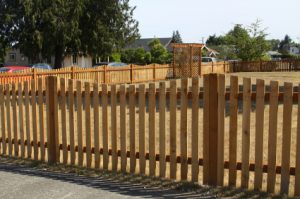
Fence Repair and Installation is not a simple task. It does take some research and planning to achieve optimal results. Installation, or repair, projects involve time, labor, materials, and money. A skilled DIY homeowner might tackle the project. For best results, consider hiring skilled fence installation experts. Little obstacles can turn into big problems when lack of knowledge and preparation stand in the path to success. Hiring skilled labor will add to the overall project budget. The ROI is well worth the money spent. To find a local licensed fence company, ask for references or research online. Ask local hardware stores or trusted friends and neighbors. Don’t waste money and time on disreputable companies and end up with an unfinished fence. In the long run, poor planning will increase the schedule and budget, aka, more $$ spent.
Ensure that the chosen fence company is licensed, insured, and knowledgeable about digging where there are buried cables, pipes, or gas lines. Check local building codes and be aware of property lines. Most municipalities, electric, gas, telephone, TV cable companies have a “call before you dig” phone number. Use an old-fashioned method, look in a phone book for fence contractors and call the local building code office. When it comes to any type of project that involves digging underground, “it is better to be safe than sorry”. Don’t dig where there are buried cable or gas lines.
The most common fences are made of wood. For fence repair, whatever the fence material involved, there will be some preliminary tasks to accomplish. Before investing money, check the entire fence for broken posts and boards. Check availability of all materials involved in the project. Plan everything in advance of the project’s start date. To avoid rainy days and lightning storms, check the weather forecast. It is easier to dig holes when the ground is soft but not muddy. If the fence project is large, consider renting power tools. Small fence repair projects can use manual tools. A reputable fence company, however, will have all the necessary tools.
Most big box retail stores, or small hardware stores, will carry hammers, nails, levels, chalk line, tile shovels, post hole diggers, aka, clam-shell diggers, ready-mix cement, buckets, and wheelbarrows which are common fence repair tools. When digging multiple fence post holes, it is hard work, don’t get overheated and avoid sunstroke. Don’t forget to wear insect repellent and be sure to stay well hydrated by drinking plenty of water. Wear a hat and rest in the shade of a tree or indoors. Fence material may consist of wood, most common, or metal, aluminum, plastic, wrought iron, or other material.
Labor cost may run from $7 to $12 per linear foot. Fence material will cost $10 to $30 per linear foot. Most city and county codes allow for fence heights to be from three to eight feet. Most fences post holes are dug to 2 ft. 4 inches deep and posts are approximately six to eight feet apart. Before beginning a fence project, check local municipal codes.
